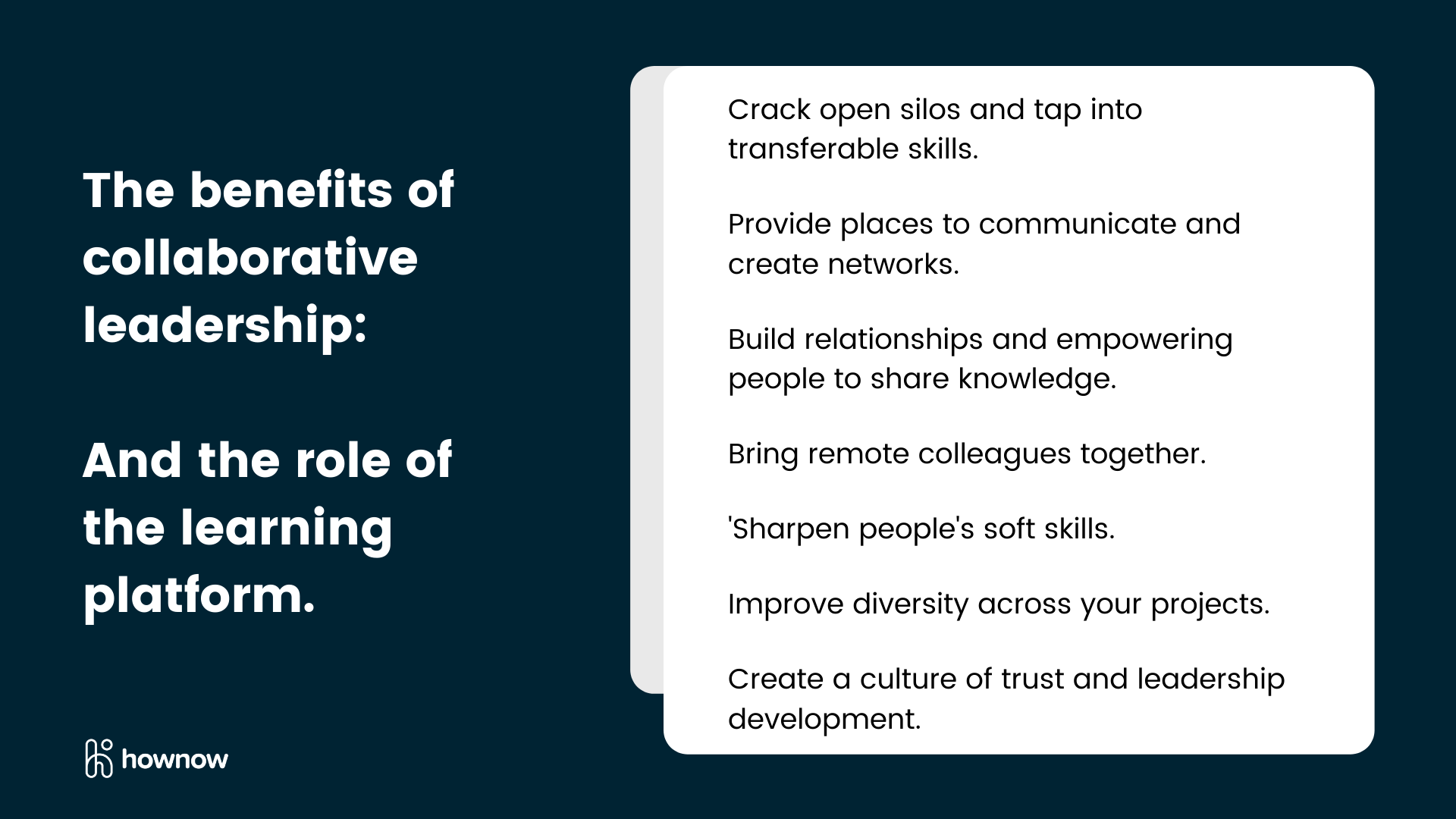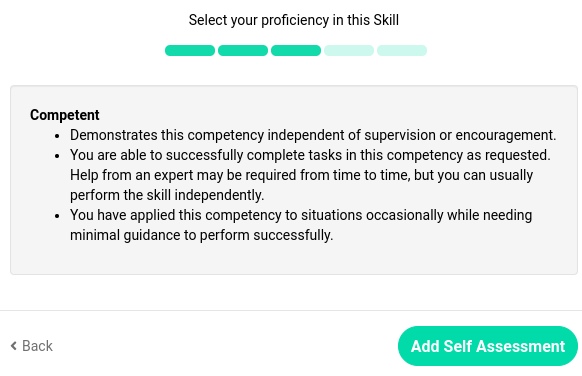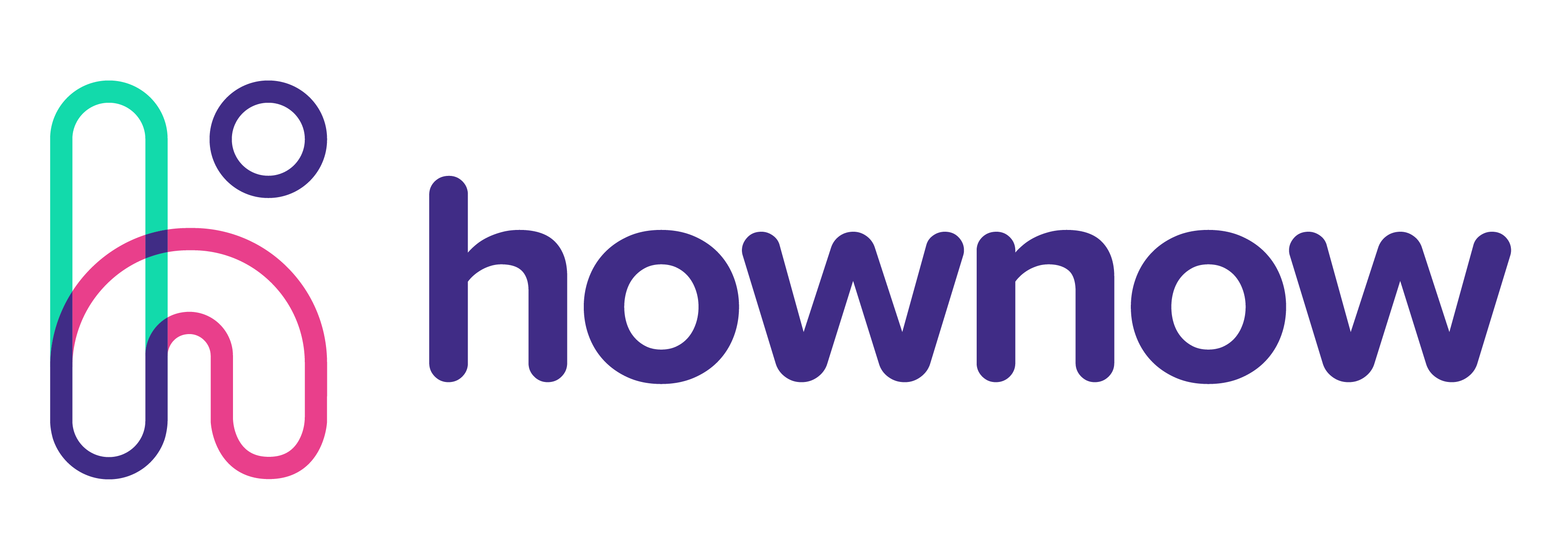Collaborative leadership: Could a learning platform be your secret weapon for shared success?
You’ve got geniuses all over your organisation, whether you’ve realised it yet or not! And it’s one of the reasons why we no longer learn in the top-down fashion, where a few people higher up are responsible for all L&D.
Subject matter experts exist in different teams and it’s partly why we’re seeing a rise in learning platforms focused on democratising learning and knowledge sharing.
Wait a minute, this is meant to be an article about collaborative leadership, right? Yes! But there are so many similarities between this movement for democratising learning and the growth of collaborative leadership that we really need to talk about the two together.
What is collaborative leadership?
It’s another one of those ‘clue’s in the name’ situations! Collaborative leadership is all about working collaboratively to solve problems and involving more of your team in the mission to achieve your goals. Rather than managers making all of the decisions, they adopt a facilitator role and bring others to the table to share their ideas.
Typically that means working across teams, to tap into the transferable skills, passion and creativity of anyone that might help you strategise more effectively. This brings a whole host of benefits, from empowering people and making them feel valued to democratising the sharing of ideas and busting knowledge out of silos.
That’s why this concept and the features of many modern learning platforms feel so similar – and why we believe a learning platform could play a key role in successful collaborative leadership. As we dig into the benefits, we’ll try to make the learning platform’s case as a key tool for pulling this collaboration off.
The benefits of collaborative leadership and the role of the learning platform

Crack open silos and tap into transferable skills
Collaboration is a little like one of those friendship groups where someone has a reputation for being the hermit. They’re happy on their own but when you twist their arm and get them to come out, they have an amazing time and really bring something else to the table. When we work in silos, we can be productive and content but we might be far happier and able to produce more when we engage with others.
Imagine you’re working in the product team and a project pops up where you need to revamp the dashboard. You could plough ahead alone or with a few of that team, but you’ll miss out on all the skills that exist in other departments. Collaborating with your customer success reps might give you better insight into the end-user perspective, the marketing team can probably add something from a messaging or branding perspective and the design staff can help shape better layout conversations if you get them involved sooner.
The two big questions this throws up for a lot of people are who do we connect with and where do we connect with them? And it’s a fair point, having structure and a central place to manage the project makes the process far easier.
This first question is where collaborative leadership meets the need to measure skills. After all, if you don’t know which people have which transferable skills, good luck transferring them to a shared purpose! In HowNow, we help you build a skills profile for each person – a place to measure which talents they’ve got and how proficient they are.

That part around having a place to connect is something we’ll cover in the other benefits we’re going to discuss in this piece.
Provide places to communicate and create networks
Sometimes it’s a Slack Channel, other times it’s one overwhelmingly long email thread, it might even be a shared spreadsheet – but where we manage our collaborative projects can have a noticeable impact on how effective they are. Especially when we think about building relationships – and that’s why the places we’ve listed off aren’t necessarily the best because they can feel busy, cluttered and chaotic.
We prefer to use groups and channels in HowNow! A group is exactly how it sounds, you’ll make a list of people for your team or project, create a group with them in and then assign the relevant content and upload it to that group as you build out the project. A channel is a way to tag content related to a certain topic or project so that it can all be found in one central place.

Rather than scrolling through your message history to find something or poking around in a huge shared folder, it’s there in your channels or at the end of a quick search – in the same platform where all your other relevant resources live.
Speaking of channels, you might be curious about how this all works in practice! We’ve got the perfect place to channel that curiosity and it’s in our on-demand product demo – where we’ll show you how channels, groups and the rest of our learning platform works.
Building relationships
When you’re bringing together the right people and giving them a place to collaborate, you’re giving them all the tools to build relationships. Especially if they’ve not worked on projects together in the past, collaborative leadership provides them with a better understanding of who does what within the company – something that can help people become more independent in seeking out subject matter experts or sharing knowledge.
When you’re doing that within a learning platform like HowNow, you’re giving them the tools to interact freely and in more forms! They can create live classes or meetings to brainstorm ideas and upload those for those who want to watch on demand. There’s the option to switch discussions on for the content you’re uploading and use that as a direct means of capturing feedback or building out shared ideas too.
Bringing remote colleagues together
It’s fair to say we’re more displaced, remote and physically disconnected from our colleagues than ever before, but that doesn’t mean we can’t collaborate! Whatever tech you’re using, figure out how it can be used to bring your remote employees together and empower them to collaborate!
It’s easy for people to keep their head down and work in those silos or to feel a little left out or disconnected when they’re working remotely, but a shift towards this collaborative mindset could be that virtual pat on the back they all need.
The benefits that have less to do with learning platforms
Yes, we’re a learning platform so hopefully, you can forgive us for focusing on those benefits first but there are plenty more when it comes to collaborative leadership!
Sharpening soft skills
Great leaders and good colleagues have those personal skills that make them fun to work with – and a collaborative style gives people the environment to hone those. Leaders can become more empathetic to how people work because they’re coming into contact more frequently, teammates can understand how their peers like to work and channel that into their social skills.
And overall, it’s creating an element of this across your organisation as you continue to do it! So, before you know it, you’ve got a culture for collaboration and teams packed full of people with enviable social skills.
Improving diversity across your projects
When you’re involving more people in projects and basing that around skills, perspectives and ideas, you’re going to have more diverse and interesting groups of people working together on projects. Especially when we consider that remote collaboration aspect because you’re removing location as a barrier and ensuring that people from different cultures are involved.
Creating a culture of trust
There’s no better feeling than knowing your opinion is valued, that you’re trusted to bring great ideas to the table and your colleagues have trust in your abilities. From a leader’s perspective, you need people to trust you but they have to feel like it’s a two-way street – bringing them into projects is a perfect way to pull that off.
A bi-product of that trust is that people often take more ownership and feel confident to take initiative! And the collaborative process also makes it easier to provide more critical or negative feedback with the trust that it’s going to be taken in the spirit it’s intended.
The creation of future leaders
When leadership doesn’t feel like a top-down and controlled hierarchy, more people have a chance to hone their leadership skills. Whether that’s taking the responsibility for a certain project or mentoring someone else as part of the progress, these are often things that happen organically when we work together towards a shared purpose.







